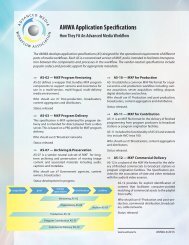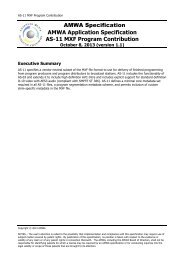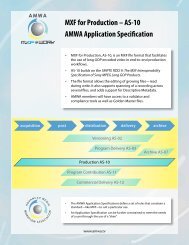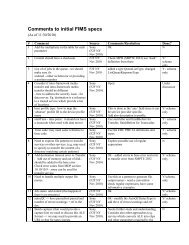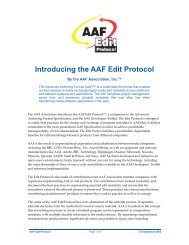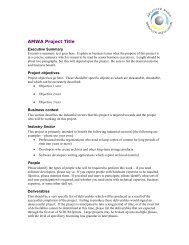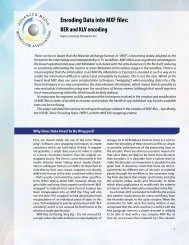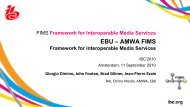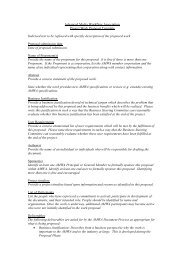Create successful ePaper yourself
Turn your PDF publications into a flip-book with our unique Google optimized e-Paper software.
<strong>FIMS</strong> <strong>Media</strong> <strong>SOA</strong> <strong>Framework</strong> Phase1 (Preliminary)• Simple service discovery: a static service discovery query is configured in the ESB, providing simpleinformation such as the service classification (e.g. find a transcoder)• Message context-based discovery: some information inside the service request can be used to select aspecific service instance. For example, information in the message on the input media format andexpected output format can be used to select a particular transcoder instance.• SLA-based endpoint discovery: Service Level Agreement information is used to match a request to aservice provider that can provide the requested level of service. (SLA documents are maintained in theservice registry).• Resource utilization-based discovery: service resources (e.g. CPU, storage, and network) utilization datais used to dynamically discover and bind to a service according to specified policies or rules (e.g. selectthe service with the lowest CPU utilization or the shortest job queue).7.1.2.1 Context-specific discoveryWe first define what we mean by context adopting the definition from [REF1]: “Context is any information thatcan be used to characterize the situation of an entity. An entity is a person, place, or object that is consideredrelevant to the interaction between a user and an application, including the user and applications themselves.”Context-aware systems look at the who’s, where’s, when’s and what’s (that is, what the user is doing) ofentities and use this information to determine why the situation is occurring and take some action, such asselecting a particular service instance to perform a business task. According to [REF1] there are certain types ofcontext that are, in practice, more important than others. These are location, identity, activity (or usage) andtime. For the scope of this document, we consider only the first three types.Location• Needs defining of the entity for which the location applies – e.g. service consumer location or mediacontent location?IdentityUsage• Needs defining of the entity for which the identity applies – e.g. user identity? or media contentidentity?• Needs defining of the entity for which the usage applies – e.g. operation on media content ?REF1. Anind K. Dey and Gregory D. Abowd “Towards a Better Understanding of Context and Context-Awareness”. Available at ftp://ftp.cc.gatech.edu/pub/gvu/tr/1999/99-22.pdf.REF2. Web Ontology Language (OWL) W3C standard. Available at http://www.w3.org/2004/OWL/Should services be self-describing? DISCUSS resource managementNB: The concept of service registry may be vendor specificPrivate committee documentWorking Draft for review by <strong>FIMS</strong> Rev v1, Nov-16-2010 Page 29 of 89



